With Earth Month coming up in April, we’re thinking about all the ways we can help preserve our beautiful planet. We’ve compiled 13 tips that will help you reduce waste starting from your trip to the store all the way through shopping, cooking, cleaning, and storing!
(This post is written by Cheerful Choices contributors, Corrin Coons and Sydney Coons.)

Disclosure: This post may contain affiliate links. All opinions are my own; I never feature a brand that I don’t love! See my disclosure policy for more details.
How can I make my kitchen more eco-friendly?
Changes can be made throughout the whole food preparation process to help reduce waste, save energy, and create a more eco-friendly kitchen. These areas include:
- Shopping
- Cooking
- Cleaning
- Storing
Sustainable Shopping Tips
Help create a sustainable kitchen before food even enters your door by following these easy sustainable shopping tips!
Tip #1: Plan Your Meals
If you plan what meals you’ll eat throughout the week before you head to the store you can ensure you’re buying only what you need. This can reduce food waste which saves you money and helps the environment – so it’s a win-win! Need help planning out your meals? Check out our Coaching + Cooking program where we can provide a full 7-day personalized meal plan.
Tip #2: Shop Local When Possible
When you’re able to, shop at your local farmers market. This reduces the distance food has to travel from where it’s produced, helping lower fuel use and harmful emissions.
In fact, one study found that conventionally sourced food used 4 to 17 times as much fuel and emitted 5 to 17 times as much carbon dioxide when compared to locally sourced food.
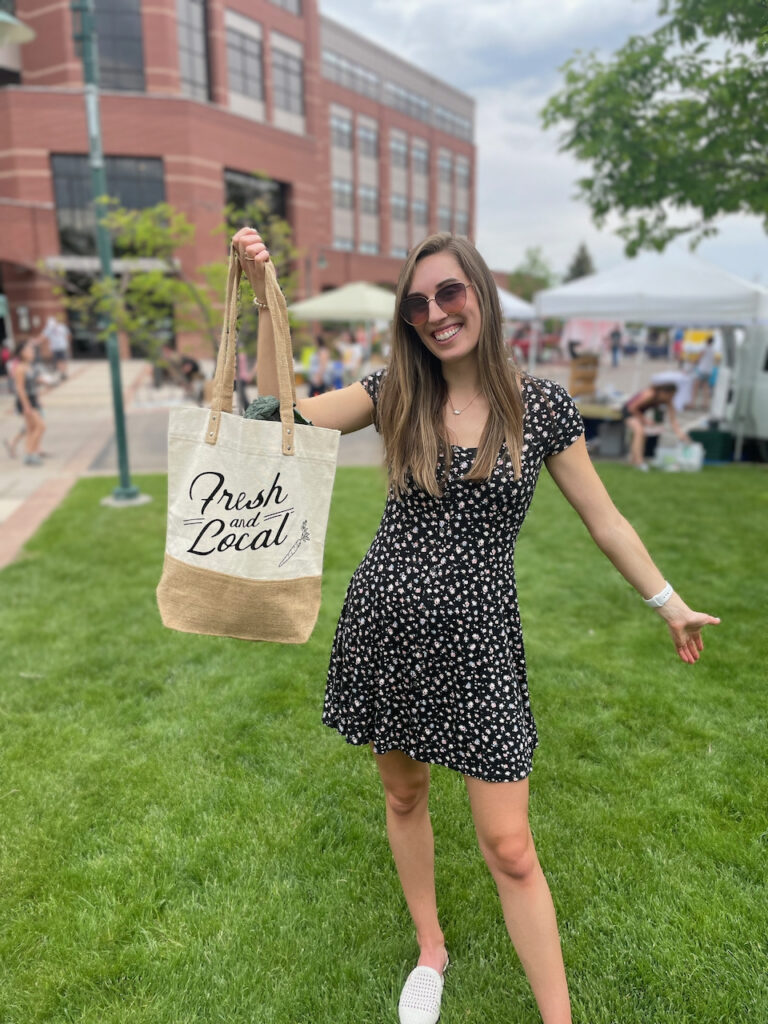
Tip #3: Buy “Ugly” Produce
Don’t waste those misshapen carrots or slightly bruised potatoes! When they’re chopped up in a stir fry or stirred into vegetable soup no one will know what they looked like at the store. Buying those “ugly” fruits and vegetables can help reduce food waste and may even save you money if they’re in a discounted section.
There’s even low cost subscription services like Misfits Market or Imperfect Foods that deliver “ugly” produce straight to your door!
Tip #4: Buy from the Bulk Section
Not only can buying in bulk save you money and reduce trips to the store, it can also reduce plastic waste. So next time you’re at the store—stock up on staples like grains, dried beans, nuts, and seeds.
Tip #5: Use Reusable Tote Bags and Produce Bags
Americans use 14 billion plastic bags a year so it’s no surprise plastic bag bans have been on the rise with 8 states in the U.S currently banning plastic bags and many more cities imposing fees. Whether there’s a ban in your state or not, you can do your part to reduce plastic waste by switching to reusable bags.
Reusable tote bags have lots of benefits over plastic bags beyond just reducing plastic pollution. For one, they’re bigger and sturdier than plastic bags which can prevent your freshly purchased groceries from ending up sprawled throughout the parking lot (admit it, this has happened to you at least once). Also, their size often leads to less trips when carrying groceries in.
Reusable produce bags are another great way to reduce plastic waste when shopping.
Lotus Sustainables has lots of great options for reusable trolley bags and produce bags! Plus, I love that they have insulated bags to help keep foods cold.

Sustainable Cooking Tips
Once you get back from the store, follow these tips to reduce food waste and promote a sustainable kitchen!
Tip #6: Save Energy while Cooking
Use only the size burner you need for what you’re cooking. Using a smaller pot or pan on a smaller burner can help save energy.
You can also save energy by leaving the oven door open after cooking to help heat your house in the winter.
Tip #7: Use Scraps from Produce
Produce scraps leftover from chopping veggies can be composted or used to make homemade veggie stock.
Tip #8: Cook with the whole food
Here are some ways to use the whole fruit and veggie:
- Use leftover fruit peels to infuse beverages like water or tea.
- Add strawberry tops or celery leaves to smoothie bowls – you won’t even be able to taste them!
- Use broccoli stems in soups, roast them, or spiralize them into noodles.
- Carrot tops can be used like parsley in most recipes, added to salads, or made into carrot top soup.
- If you’re wondering what to do with fruit and veggie scraps, a simple search online pulls up tons of helpful recipes, so get creative and have fun!
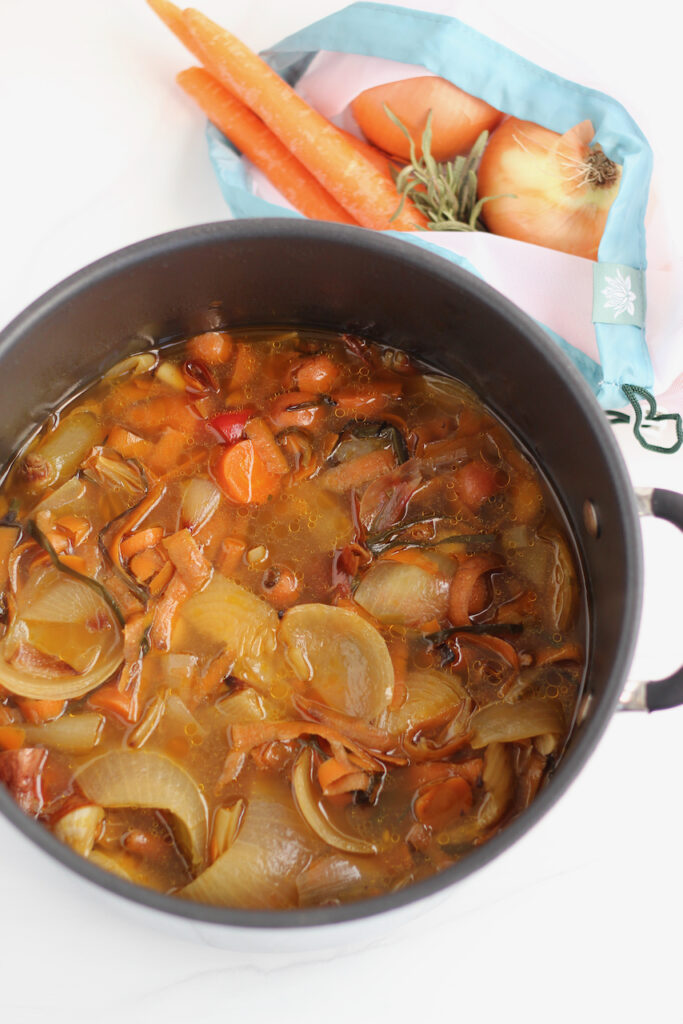
Tip #9: Use Up Your Leftovers
A lot of energy, resources, and money went into getting food on your plate, so do your best to use up any leftovers you have. You can do this by having a “leftover night” in your house to clean out the fridge. Along with reducing food waste, this allows you to experiment and have fun putting new meals together!
If you’re not sure what to do with your leftovers, check out this leftovers guide for tips on how to reuse all types of leftovers from cooked vegetables to leftover sauces and dips.
Sustainable Cleaning Tips
Follow these tips when cleaning up after a delicious meal to help preserve resources and make your kitchen more sustainable.
Tip #10: Use Reusable Paper Towels and Rags
Since paper towels are single-use, purchasing reusable paper towels and rags is an easy way to reduce the amount of paper waste generated when cleaning. Plus, you’ll save money not having to buy a roll of paper towels every time you go to the store!
Tip #11: Clean Dishes Effectively
Try to clean dishes right away so they’re easier to clean and use less water.
If you only have a few dishes to wash, wash them by hand using soapy water filled up in the sink rather than running water. However, if you have lots of dishes it actually uses less water to pack your dishwasher full and use it instead.
Sustainable Storing Tips
Whether you’re storing food before cooking it or saving leftovers for later, follow these tips to store food sustainably.
Tip #12: Use Food Huggers and Silicone Bags
Plastic wrap and plastic bags are commonly used to store food, but these are single-use plastics that can be easily swapped out for reusable alternatives:
- Food Huggers function just like plastic wrap to keep food fresh but without the hassle of getting stuck or folded, and they can be used over and over.
- Silicone Stasher bags can be used instead of plastic bags to store food or pack your lunch in. They can then be easily cleaned and reused! They can also withstand heat, sous vide, and freezing.
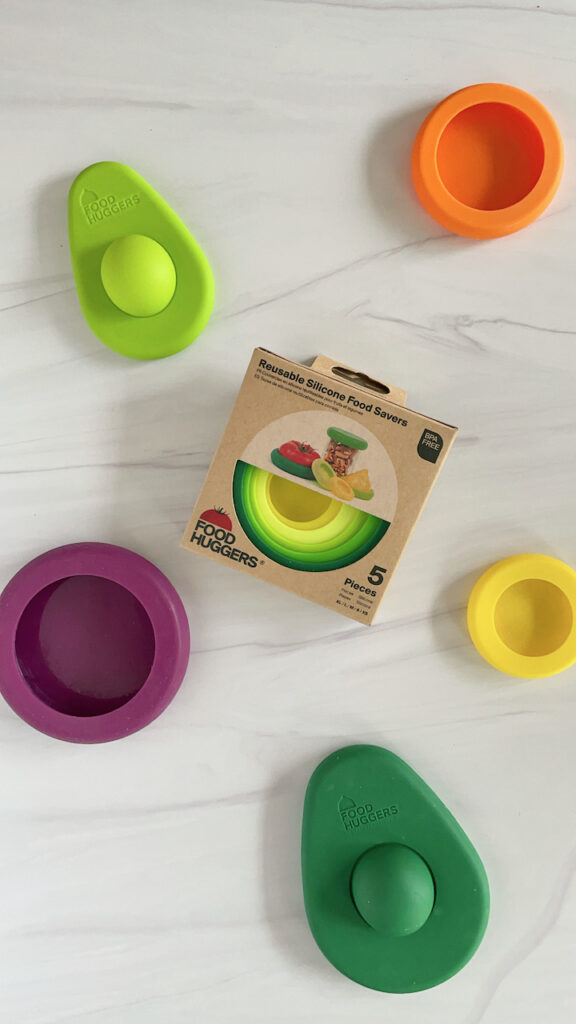
Tip #13: Store Foods Correctly to Reduce Food Waste
Know what foods should be stored in the fridge versus on the counter. Here are some basic tips to keep in mind:
- Bread stales faster in the fridge, so consider keeping it in your pantry or freeze extras.
- Lemons and limes last longest when stored in the crisper drawer of the fridge.
- Keep herbs like cilantro and parsley in a glass jar in some water to make them last longer.
- Store greens with a paper towel on top to collect excess moisture.
- Berries about to go bad? Freeze them to use in a smoothie or dessert bake later.
When storing food it’s also helpful to label it with the date it must be used by. This makes it easier to see which foods should be used first and ensures leftovers are used up in time. A general rule of thumb is to throw out refrigerated leftovers within 3 to 4 days and frozen foods after 3 to 4 months.
Key Takeaways
As you can see, there are many strategies you can use at various steps in the shopping, cooking, cleaning, and storing process to help make your kitchen more sustainable! But remember, eco-friendly practices take time to implement, so start slow. Make it a goal to implement 1 or 2 at a time.
We hope these tips help you show your appreciation for our planet and celebrate Earth Month!
save this sustainable kitchen guide on pinterest:
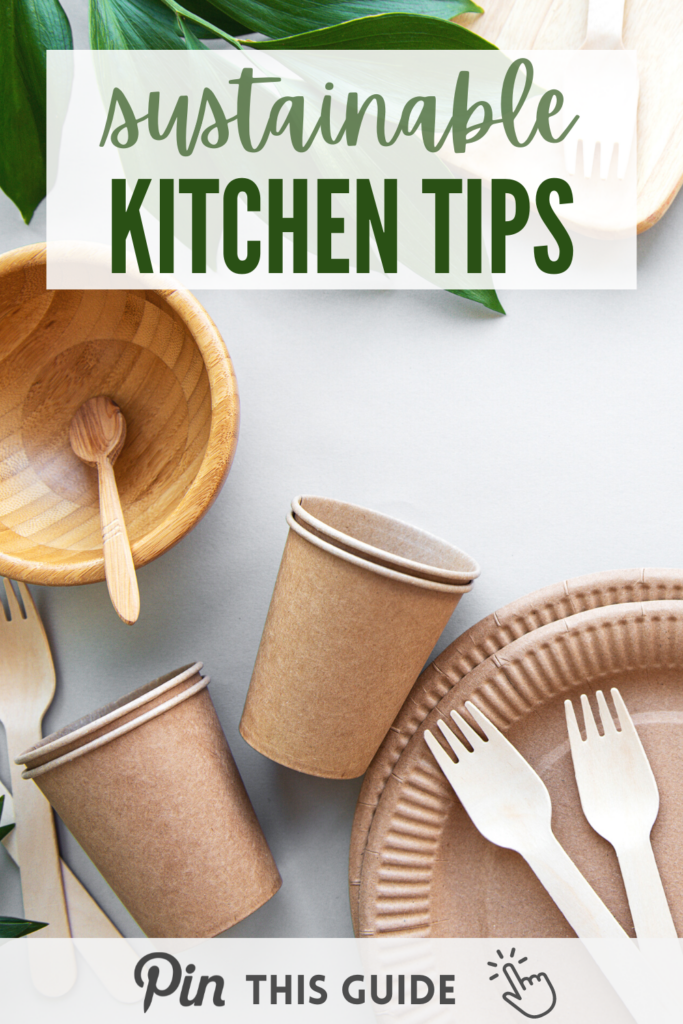
Need more help with recipes for your busy schedule?
In my coaching + cooking program, I help busy people with beginner cooking knowledge become confident in the kitchen so that they can enjoy nourishing foods they love and stress less about mealtime. Click here to learn more about this virtual program led by a dietitian.

Bio: Corrin and Sydney are both Registered-Dietitians-to-be from Westminster, Colorado who are passionate about helping others through food and nutrition. They are both currently Food Science and Human Nutrition majors at Colorado State University looking to graduate in 2023 and pursue their Masters in Dietetics. In their free time, Sydney and Corrin enjoy backpacking in the Colorado mountains, doing yoga, and cooking new recipes. They love sharing their passion for food with others and providing food inspiration on their Instagram page. You can connect with them on Instagram @nutri.liciouseats!

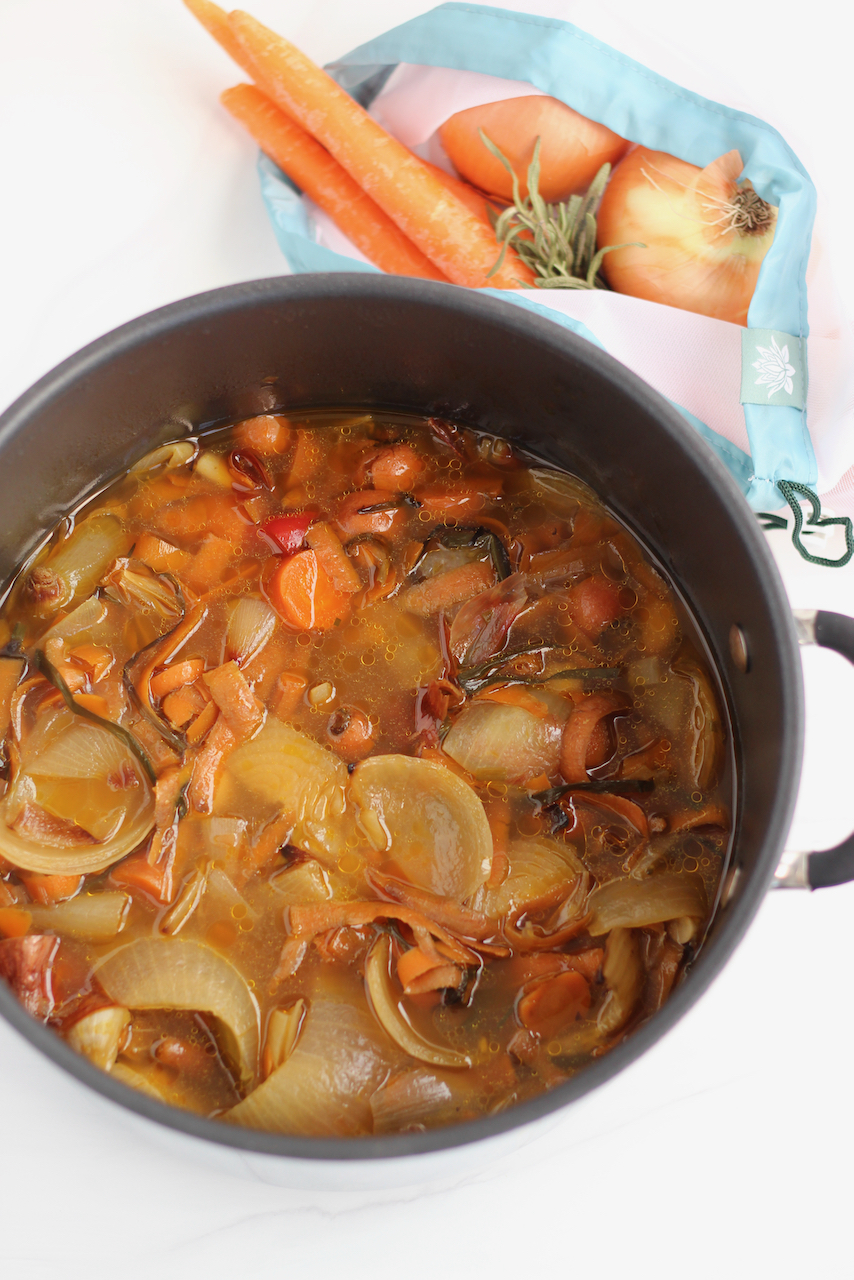



![RECIPE below! 🍠 Sweet potato smoothie bowl! [#sponsored]
INGREDIENTS:
• 1 Bako Single Sweet Potato (steamed then cut into cubes & frozen)
• 1/2 frozen banana
• 1/4 to 1/2 cup unsweetened almond milk (depending on blender used)
• 1/4 cup plain greek yogurt
• 1 scoop chocolate protein powder
• 1 Tbsp almond butter
• 1/2 tsp vanilla extract
• 1/2 tsp ground cinnamon
Blend all ingredients until smooth (scraping down in between if needed). Then top with chocolate chips, toasted sliced almonds, cocoa nibs, and berries.
I love sweet potatoes because they’re filled with fiber, potassium, and beta-carotene… which is an antioxidant that’s important for healthy skin and vision!
#partner #bakosweet #sweetpotatoes #smoothiebowl #dietitiansofig](https://cheerfulchoices.com/wp-content/plugins/instagram-feed/img/placeholder.png)

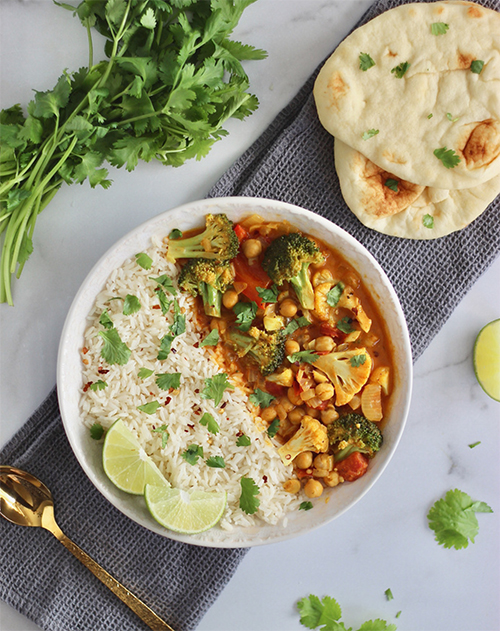
0 Comments